What is Bitcoin Mining?

We all know that paper money is printed by the central bank of a nation. But where does Bitcoin come from, since there is no central bank or government involved in its functioning? This digital currency is mined or generated in a unique way that involves the use of special software to solve problems. Bitcoin mining can be exciting, but only if you understand it well.
Bitcoin Mining and Bitcoin Rewards
Bitcoin Mining is a type of lottery or competition, where miners compete with hardware to earn Bitcoins. All Bitcoin transactions are verified and added to a public ledger, called the block chain. The process of distinguishing legitimate Bitcoin transactions from attempts to re-use currency that has already been used via the “Proof of Work” or POW function is also part of Bitcoin mining.
This public ledger is also the means through which new Bitcoins are released. So, who can participate in this mining? Anyone with access to the internet and requisite hardware can do so, since the mining process involves compiling recent transactions into blocks and trying to solve a difficult puzzle. The participant who succeeds in solving the puzzle gets to place the next block on the block chain and claim the reward. The rewards include the transaction fees associated with the transactions compiled in the block plus a newly released Bitcoin. The ideal average mining time has been established as ten minutes per new block.
Recent years have seen the use of a pooled mining approach, wherein a group of individual miners contribute to the generation of a block, and then split the block reward according the contributed processing power. The number of new Bitcoins released with each mined block is called the block reward and the same is halved after every 210,000 blocks or a period of four years. The reward that started at a level of 50 in 2009 was halved to 25 in 2014 and is set for another downward revision soon.
Complexity of Bitcoin Puzzles
While all this might sound like a fun way to make some money, the Bitcoin Puzzles are neither simple nor easy to solve. It all depends on the overall effort being put into mining across the network. Also, the difficulty level of mining can be adjusted, which is actually done after every 2016 blocks or a period of two weeks. The difficulty levels are adjusted in such a way as to keep the rate of block discovery constant. For instance, if more computational power is being employed in mining, difficulty levels rise to make the whole process harder. Similarly, if less computational power is being employed, the difficulty level gets reduced to make mining easier and keep the block discovery rate constant.
I am sure the next question on your mind is: Where is Bitcoin mining done? Computers? Yes, initially it was done with CPUs from normal desktops, but recent years have seen the use of graphics cards or graphics processing units. This was followed by the development of special hardware, known as Application Specific Integrated Circuit or ASIC, for the mining of Bitcoins. Mining is more cost effective when done through the latest ASICs instead of via CPUs, graphic cards or the older versions of ASICs, because the cost of energy consumption is greater than the revenue generated in the latter case.
Bitcoin Cloud Mining
So, what is the solution for people looking to get Bitcoins without having to invest in hardware, electricity, software, bandwidth and others? The answer lies in Cloud Mining. In this case, all mining is done remotely on the cloud, which allows users to purchase mining capacity of hardware in data centres. Although this option allows a user to cut costs on investment in hardware and software, besides not having to deal with electricity and other issues, it limits the ability to modify the software while reducing profitability. Also, there are high chances of fraud in such cases.
To conclude, Bitcoin mining is an interesting concept that allows users to generate Bitcoins by using their hardware and software to resolve block puzzles. Interested users have the option to mine on their own, become a part of a Bitcoin mining pool or use a cloud.
Disclaimer
If you liked this educational article please consult our Risk Disclosure Notice before starting to trade. Trading leveraged products involves a high level of risk. You may lose more than your invested capital.




